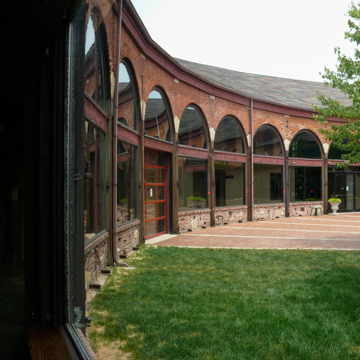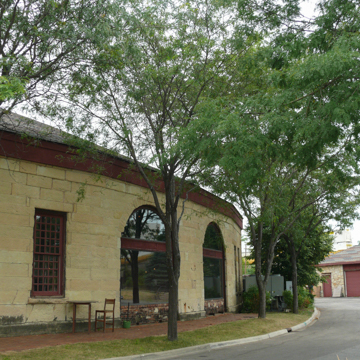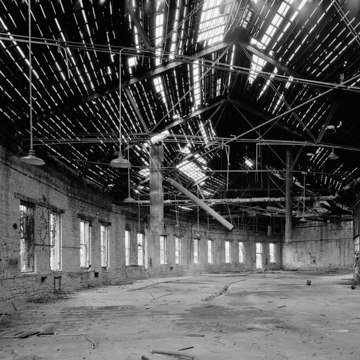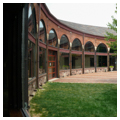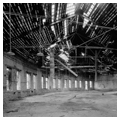You are here
Chicago, Burlington and Quincy Roundhouse and Shop
This is the oldest extant railroad roundhouse in the United States as well as the nation’s only stone roundhouse. It is an important remnant of what had been the largest railcar construction and repair shops in the Midwest. It was built beginning in 1856 by the Chicago and Aurora Railroad (later the Chicago, Burlington and Quincy or CB&Q), which was the first railroad to link Chicago with the Mississippi River.
As an established industrial city along the Fox River, Aurora was a practical location for a complex of shops devoted to the repair, construction, and servicing of the railroad’s steam locomotives. Over a two-year span, seven buildings were constructed, including the roundhouse, an engine room, and shops for blacksmiths, car repair, carpentry, locomotive repair, and painting. Today, only the roundhouse and locomotive repair shop, two of the largest at the site, remain.
J.R. Coulter Builders erected the initial 22-bay section of the roundhouse in 1855–1856 based on a design by Levi Hull Waterhouse (1824–1905) with architect C. F. Allen. Round sheds for locomotive engines were developed in Derby, England, in 1839. A circular structure with a central turntable permitted repair teams to redirect steam locomotives to various sidings throughout the rail yard.
In Aurora, an eight-stall section was added to the CB&Q Roundhouse in 1859; the final 10-stall addition was built in 1866. Though the 264-foot-diameter structure appears to be a regular circular, it is in fact a 40-sided tetracontagon. The exterior is constructed of buff-colored dressed limestone blocks quarried in nearby Batavia. The 18-foot-tall walls feature rectangular window and door openings with stone lintels and sills. The circular exterior shape is repeated on an interior red brick wall—160 feet in diameter—composed of brick arches and iron columns. The space between the two walls creates a 50-foot-wide interior that is covered by a gable roof supported by steel truss supports and rafters.
Only two other railroad roundhouses still stand in North America and both were built after the CB&Q Roundhouse: the Baltimore and Ohio Roundhouse (1884) in Baltimore and the John Street Roundhouse (1921–1931) in Toronto.
The turntable in the CB&Q Roundhouse was removed in 1925, after electric and diesel engines had largely replaced steam locomotives. Most of the complex had closed by 1974, when its owner, Burlington Northern Railroad, began to demolish the stone and brick shop buildings. By 1982, the demolition of the roundhouse was imminent but the City of Aurora stepped in to save it, along with an adjacent 50 x 180-foot stone structure (built 1855–1857) that had served as a locomotive repair shop. That building’s rectangular window and door openings have stone lintels and sills, while its gable roof is supported by steel trusses and rafters.
In 1988, the locomotive shop was restored for use as a commuter railroad station and offices. In 1995, the roundhouse was rehabilitated for use as a restaurant and brewery complex, as part of the revitalization of this former industrial area along the Fox River into an entertainment district.
References
Aurora Historical Society, “Chicago, Burlington, & Quincy Roundhouse and Locomotive Shop,” Kane County, Illinois. National Register of Historic Places Inventory–Nomination Form, 1978. National Park Service, U.S. Department of the Interior, Washington, D.C.
American Society of Mechanical Engineers. ASME Bulletin #132: Chicago Burlington & Quincy Railroad Roundhouse.Washington, D.C.: ASME, 1988.
Hawkins, Chris, and George Reeve. “Engine Sheds.” Railway Architecture. New York: Van Nostrand Reinhold Company, 1979.
Writing Credits
If SAH Archipedia has been useful to you, please consider supporting it.
SAH Archipedia tells the story of the United States through its buildings, landscapes, and cities. This freely available resource empowers the public with authoritative knowledge that deepens their understanding and appreciation of the built environment. But the Society of Architectural Historians, which created SAH Archipedia with University of Virginia Press, needs your support to maintain the high-caliber research, writing, photography, cartography, editing, design, and programming that make SAH Archipedia a trusted online resource available to all who value the history of place, heritage tourism, and learning.










